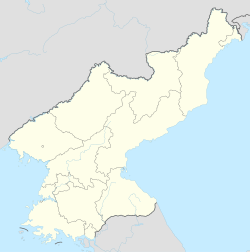Kijong-dong
Kijong-dong
기정동 機井洞 | |
|---|---|
 The Panmunjom flagpole, flying the flag of North Korea. | |
| Nickname: Propaganda Village | |
| Coordinates: 37°56′43″N 126°39′20″E / 37.9453°N 126.6556°E |
Kijŏng-dong, Kijŏngdong, or Kijŏng tong is a village in P'yŏnghwa-ri (Korean: 평화리; Hancha: 平和里),[1] Kaesong-si,[2] North Korea. It is situated in the North's half of the Korean Demilitarized Zone (DMZ).[3] Also known in North Korea as Peace Village (Korean: 평화촌; Hancha: 平和村; MR: p'yŏnghwach'on),[4] it has been widely referred to as 'Propaganda Village' by those outside North Korea, especially in Western and South Korean media (Korean: 선전마을; Hanja: 宣傳마을; RR: seonjeon maeul).[5][6][7][8][3]
Kijŏng-dong is one of two villages permitted to remain in the 4-kilometer-wide (2.5 mi) DMZ set up under the 1953 armistice ending the Korean War;[7][9] the other is the South Korean village of Daeseong-dong,[9] 2.22 kilometers (1.38 mi) away.
History


The official position of the North Korean government is that the village contains a 200-family collective farm, serviced by a child care center, kindergarten, primary and secondary schools, and a hospital.[10] However, observation from the South suggests that the town is an uninhabited village built in the 1950s in a propaganda effort to encourage South Korean defection and to house the DPRK soldiers manning the network of artillery positions, fortifications and underground marshalling bunkers that surround the border zone.[3][4][11][12]
The village features a number of brightly painted, poured-concrete multi-story buildings and apartments, many apparently wired for electricity. The town was oriented so that the bright blue roofs and white sides of the buildings next to the massive DPRK flag would be the most distinguishing features when viewed from across the border. Scrutiny with modern telescopic lenses, however, has led to the conclusion that the buildings are concrete shells lacking window glass or even interior rooms,[11][13] with building lights turned on and off at set times and empty sidewalks swept by caretakers in an effort to preserve the illusion of activity.[14]
The village is surrounded by extensive cultivated fields clearly visible to visitors to the North Korean side of the DMZ.[citation needed]
Flagpole
In the 1980s, the South Korean government built a 98.4 m (323 ft) tall flagpole with a 130-kilogram (287 lb) flag of South Korea in Daeseong-dong (37°56′30.24″N 126°40′48.07″E / 37.9417333°N 126.6800194°E).
The North Korean government responded by building an even taller one, the Panmunjom flagpole, at 160 m (525 ft) with a 270 kg (595 lb) flag of North Korea in Kijŏng-dong, 1.2 km (0.7 mi) across the demarcation line from South Korea (37°56′42.99″N 126°39′18.78″E / 37.9452750°N 126.6552167°E), in what some have called the "flagpole war". For over a decade, the flagpole was the tallest in the world.[11] In 2010, the flagpole became the second tallest in the world at the time, after the National Flag Square in Baku, Azerbaijan at 162 m (531 ft).[11][15][16] It is now the fourth tallest flagpole in the world, after the Dushanbe Flagpole in Tajikistan, at 165 m (541 ft), and the Jeddah Flagpole in Saudi Arabia, at 170 m (558 ft).[citation needed]
Propaganda loudspeakers
Massive loudspeakers mounted on several of the buildings deliver DPRK propaganda broadcasts directed towards the South.[11] Originally the content extolled the North's virtues in great detail and urged disgruntled soldiers and farmers simply to walk across the border to be received as brothers.[17] Eventually, as its value in inducing defections proved minimal,[18] the content was switched to condemnatory anti-Western speeches, agitprop operas, and patriotic marching music for up to 20 hours a day.[17] For a period from 2004 to 2016, both North and South agreed to end their loudspeaker broadcasts at each other.[19] The broadcasts have since resumed after escalating tensions as a result of the January 2016 nuclear test.[20]
See also
References
- ^ 기정동(機井洞)[트느피마을, 틀늪]. 북한지역정보넷 (North Korean Human geography) (in Korean). Galhyeon-dong, Seoul: 평화문제연구소. 2007-12-08. Retrieved 2010-04-11.
- ^ P'yŏnghwa-ri belonged to P'anmun-gun (Korean: 판문군; Hancha: 板門郡) until the creation of Kaesong Industrial Region in November 2002, when P'anmun-gun was dissolved and its territory divided among Kaesong, Changp'ung-gun and Kaep'ung-gun. P'yŏnghwa-ri joined Kaesong.[permanent dead link]
- ^ a b c Tran, Mark (2008-06-06). "Travelling into Korea's demilitarised zone: Run DMZ". The Guardian. London. Retrieved 2009-07-05.
Kijong-dong was built specially in the north area of DMZ. Designed to show the superiority of the communist model, it has no residents except soldiers.
- ^ a b "Kijungdong, North Korea's Propaganda Village" November 12, 2006
- ^ "Korean Demilitarized Zone" Globalsecurity.org
- ^ 북한의 기정동 선전마을. TourDMZ.com (in Korean). Retrieved 2006-10-09.
- ^ a b Kozaryn, Linda D. (1997-04-14). "Cohen: Economic Failure Plagues North Korea". DefenseLink. U.S. Department of Defense. American Forces Press Service. Retrieved 2009-07-05.
- ^ Mansfield, Paul (1997-06-22). "'This is Freedom Village,' said Sgt Manfull". The Independent. London. Retrieved 2009-07-05.
- ^ a b Flack, T.D. (2008-02-19). "DMZ sixth-graders become graduates". Stars and Stripes (Pacific ed.). Tokyo. Retrieved 2009-07-05.
- ^ A Sightseeng Guide to Korea by Pang hwon Ju & Hwang Bong Hyok, Foreign Languages Publishing House, Pyongyang, DPRK. 1991
- ^ a b c d e Potts, Rolf. Korea's No-Man's-Land. Salon, February 3, 1999
- ^ Sullivan, Kevin. Borderline Absurdity: A Fun-Filled Tour of the Korean DMZ. Washington Post Foreign Service, January 11, 1998.
- ^ O'Neill, Tom. "Korea's DMZ: Dangerous Divide". National Geographic, July 2003.
- ^ Silpasornprasit, Susan. "Day trip to the DMZ: A look inside the Korean Demilitarized Zone". IMCOM-Korea Region Public Affairs Office, US Army. Archived from the original on 30 March 2009. Retrieved 30 January 2009.
- ^ "Korea's DMZ: 'Scariest place on Earth'". 2002-02-20. Retrieved 2007-10-23.
- ^ 개성에 '구멍탄' 5만장 배달했습니다. economy.ohmynews.com (in Korean). Retrieved 2006-12-06.
- ^ a b "Kijŏng-dong, North Korea « Daily Propaganda". Dailypropaganda.com. 2011-05-06. Retrieved 2012-02-21.
- ^ [1][dead link]
- ^ "Koreas switch off loudspeakers". BBC. 15 June 2004. Retrieved 7 May 2013.
- ^ http://www.bbc.co.uk/news/world-asia-35278451

